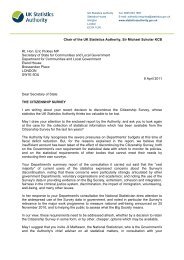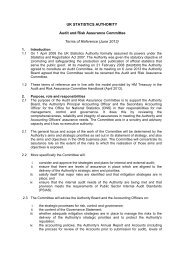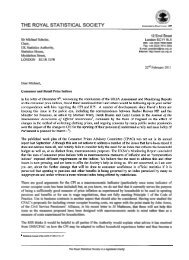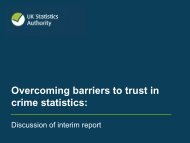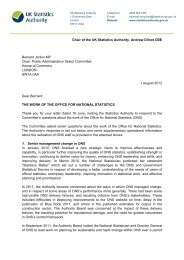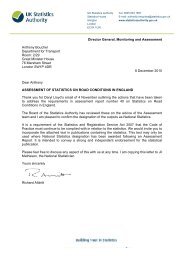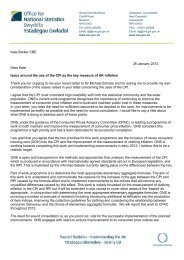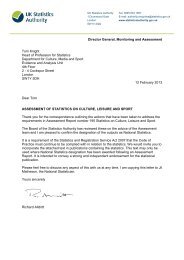The Government Statistical Service - UK Statistics Authority
The Government Statistical Service - UK Statistics Authority
The Government Statistical Service - UK Statistics Authority
You also want an ePaper? Increase the reach of your titles
YUMPU automatically turns print PDFs into web optimized ePapers that Google loves.
A series of improvements have been<br />
made to port surveys, including<br />
introducing additional survey shifts<br />
at key ports for the International<br />
Passenger Survey<br />
requirements of the new e-Borders<br />
system – which has been initiated and<br />
will achieve 95 per cent coverage by the<br />
end of 2010 – will be incorporated into<br />
the programme. This is a major new<br />
initiative that has the potential to provide<br />
a rich source of information on migrants<br />
as they enter or leave the <strong>UK</strong>, leading<br />
to more robust international migration<br />
estimates.<br />
Local Population Estimates<br />
At the end of 2007, the publication of<br />
new estimates of short term migrants at<br />
a high geographic level began – covering<br />
those people staying or leaving for less<br />
than 12 months and filling a gap in the<br />
suite of outputs. Over the course of<br />
the year this continued, along with the<br />
development of a method for supplying<br />
this output at a finer geographic level –<br />
to provide a fuller picture of migration for<br />
local authority areas.<br />
Techniques are also being developed<br />
for improving the measurement of<br />
internal migration (moves within<br />
the <strong>UK</strong>) of students. This is an area<br />
recognised as requiring development<br />
since the standard source for measuring<br />
internal migration (GP registrations)<br />
does not pick up all moves in this age<br />
group. Aggregate data from the Higher<br />
Education <strong>Statistics</strong> Agency containing<br />
term-time address of students in higher<br />
education establishments are being used<br />
to adjust internal migration estimates to<br />
compensate.<br />
Administrative sources provide a timelier<br />
source as the basis for estimating the<br />
geographic distribution of international<br />
migration than the 2001 Census currently<br />
used. <strong>The</strong> GSS has been developing a<br />
model-based approach that combines<br />
several administrative sources to provide<br />
a more representative and current<br />
distribution of international migration at<br />
the local authority level.<br />
Alternative Sources<br />
<strong>The</strong> <strong>Statistics</strong> and Registration <strong>Service</strong><br />
Act 2007 allows the laying of regulations<br />
to permit data-sharing for statistical<br />
purposes between public bodies and<br />
the <strong>UK</strong> <strong>Statistics</strong> <strong>Authority</strong>. One such<br />
regulation was laid early in 2009 to allow<br />
ONS to share the School Census data<br />
owned by the DCSF. This useful source<br />
provides more information on movements<br />
of the school-aged population.<br />
ONS is also sharing Migrant Worker<br />
Scan data (National Insurance Numbers<br />
allocated to foreign workers) owned<br />
by HMRC and DWP, which gives an<br />
indication of international migration<br />
within the economically active<br />
population.<br />
Chapter 4 | 67



